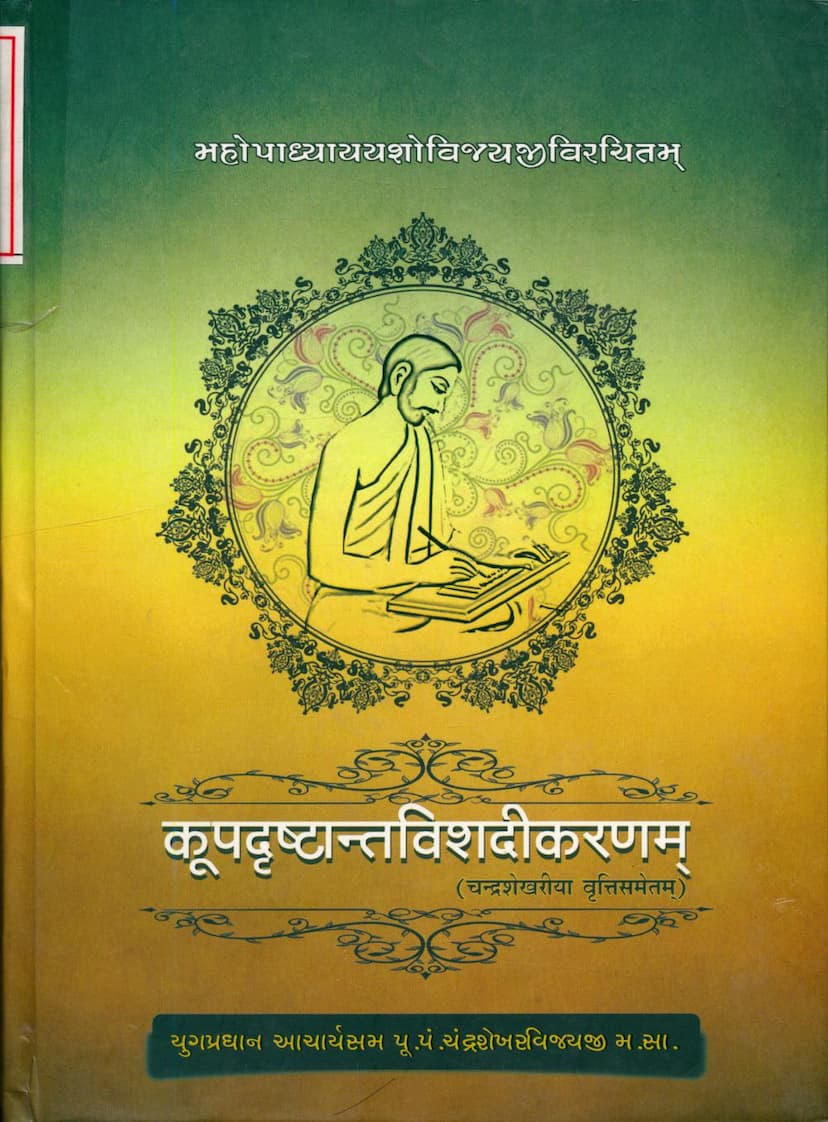Kupdrushtant Vishadikaranam
Added to library: September 2, 2025

Summary
Here's a comprehensive summary of the Jain text "Kupdrushtant Vishadikaranam" by Mahopadhyaya Yashovijay and its commentary "Chandrashekharia Vritti" by Muni Gunhansvijay:
Overall Purpose and Core Argument:
The text "Kupdrushtant Vishadikaranam" (Clarification of the Well Analogy) by Mahopadhyaya Yashovijay, with the commentary "Chandrashekharia Vritti" by Muni Gunhansvijay, aims to defend and clarify the practice of Jain worship (Jinpuja), particularly concerning the apparent conflict between the Jain principle of non-violence (Ahimsa) and the inherent violence (Himsa) involved in using living substances like water, flowers, etc., in worship. The central argument, illustrated through the "Well Analogy," is that despite the superficial violence involved in certain religious practices like Jinpuja, when performed with proper devotion and adherence to specific principles, the ultimate outcome is not sinful but rather leads to purification and merit.
The Well Analogy Explained:
The "Well Analogy" is introduced to explain this concept. When digging a well, one initially experiences:
- Fatigue: The physical exertion of digging.
- Dirt and Grime: The body gets soiled with mud.
- Thirst: The exertion increases the need for water.
However, once the well is dug and water is found:
- Fatigue is Vanquished: Bathing in the water removes tiredness.
- Dirt is Washed Away: Bathing cleanses the grime.
- Thirst is Quenched: Drinking the water satisfies thirst.
The analogy then applies this to Jinpuja:
- Initial "Violence": The act of using water, flowers, etc., for worship, which involves harming subtle Jivas (living beings), is likened to the initial fatigue, dirt, and thirst in digging a well.
- Ultimate Merit and Purification: The devotion and proper intention (Shubhav) associated with Jinpuja are like the water from the well. This devotion purifies the practitioner, washes away the "sins" (or reduces their karmic impact), leads to significant merit accumulation, and ultimately results in purification (Nirjara).
Key Themes and Arguments Discussed:
The text delves into several nuanced points to support its argument:
-
The Nature of Violence in Worship:
- The text acknowledges that using substances like water and flowers (Jal, Pushpa, etc.) involves causing harm to subtle Jivas.
- However, it distinguishes between different types of Himsa and the intent behind the action.
-
The Importance of Devotion (Bhakti) and Intention (Shubhav):
- The core of the argument lies in the power of sincere devotion and pure intention. When Jinpuja is performed with complete Bhakti and Shubhav, even the inherent violence is rendered ineffective in terms of karmic sin accumulation.
- The text emphasizes that how the puja is performed (the inner attitude) is more critical than the external actions themselves.
-
Distinction between Different Types of Worship:
- Vidhi-Bhakti Yukta Puja (Worship with Proper Rituals and Devotion): This type of worship, when performed correctly, is considered completely free from sin, despite superficial violence.
- Avidhi-Bhakti Yukta Puja (Worship with Improper Rituals/Ignorance and Devotion): Even this type, when performed with devotion, can lead to purification and merit, though it might involve some minor karmic impurities due to ignorance. The devotion helps to mitigate these.
-
Critique of Opposing Views (Purvapaksha):
- The text extensively engages with and refutes opposing viewpoints, particularly those attributed to Abhaydev Suri.
- The Purvapaksha (the opposing argument) often focuses on the literal interpretation of violence and the potential for sin even in seemingly pious acts. The text systematically dismantles these arguments by highlighting the importance of scriptural interpretation, the nuanced understanding of Jiva, and the ultimate efficacy of devotion.
-
Scriptural Interpretation and Nuance:
- The text rigorously analyzes various Jain scriptures and commentaries, including the Niryukti, Panchashaka, Bhagavati Sutra, Brihatkalpa Bhashya, and Nishiha Bhashya, to support its interpretations.
- It delves into the meaning of specific terms and concepts, such as Atmadravya, Bhava, Yoga, Adhyavasaya, and different types of Himsa and Nirjara.
-
The Role of "Anekantavada" (Multi-faceted Reality):
- The text embodies the Jain principle of Anekantavada by presenting a complex and multi-layered understanding of religious practice, acknowledging apparent contradictions and resolving them through deeper analysis.
-
Specific Examples and Analogies:
- Beyond the central Well Analogy, the text uses other analogies and examples, such as the case of the poor woman (Durgat Nari) who attained divinity through simple flower worship, to illustrate the power of devotion.
-
The Commentary's Contribution:
- Muni Gunhansvijay's "Chandrashekharia Vritti" provides a detailed and accessible explanation of Mahopadhyaya Yashovijay's profound work. It clarifies the philosophical and scriptural points, making the text more understandable for students and scholars. The commentary also highlights the significance of the work and its connection to the teachings of Acharya Chandrashekharvijayji.
In essence, "Kupdrushtant Vishadikaranam" argues that Jinpuja, when undertaken with devotion and an understanding of its ultimate purpose, is not a sinful act but a highly meritorious one, capable of purifying the soul and leading to spiritual progress. The initial "violence" is a superficial aspect that is overcome by the profound merit generated through pure devotion and the right understanding of Jain philosophy.